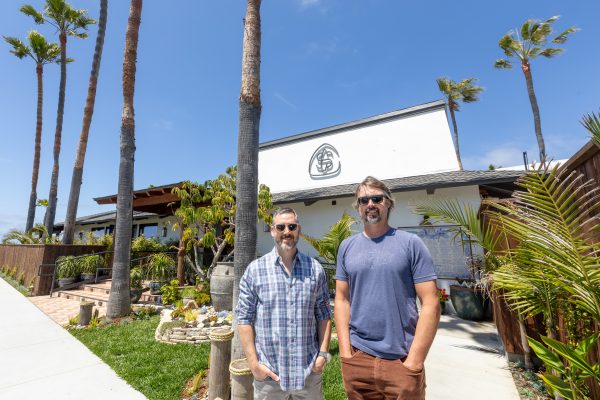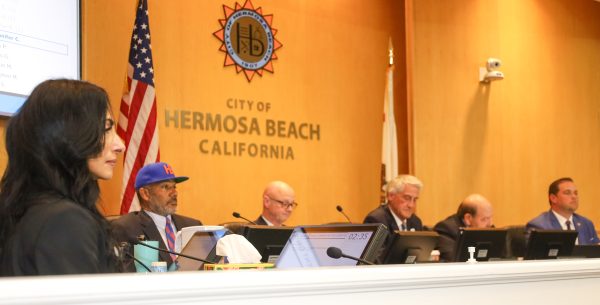by Mark McDermott
Manhattan Beach’s great philosopher, former City Comptroller Henry Mitzner, had two sayings that are still oft repeated in City Hall, even though he retired three years ago after a 47 year career.
Mitzner’s first dictum: “The most important thing is the good health of you and your loved ones, your honor, your integrity and your good name.”
Mitzner’s second dictum: “When it’s bad out there, it’s good here, and when it’s good out there, it’s great here!”
Mitzner’s wisdom bears remembering as we take a look at the year that was in Manhattan Beach, because locally, 2023 had plenty of challenges. Police fought a crime wave, the tensions from the war in Gaza spilled over at the middle school, a passionately opposed housing development was approved, a pack of coyotes continued to roam the streets, and the City lost a truly heroic young man, MBPD Officer Chad Swanson.
Swanson’s name and heroic legacy will live on, and his loss was a tragic reminder of the important things in life. And as a community, Manhattan Beach tends to rise up to meet its challenges, and did so again this year.
Bruces sell land back
At the very beginning of 2023, the Bruce family agreed to sell the beachfront property that historically was Bruce’s Beach resort back to the County of Los Angeles for $20 million.
The sale marked the completion of an historic act of restorative justice. Willa and Charles Bruce, pioneering Black entrepreneurs who built an oceanside resort for the Los Angeles African American community, were forced to sell the land to the City of Manhattan Beach nearly a century ago in a racially motivated use of the power of eminent domain. For three generations, the loss of that land — and of the American dream which it had represented — had been a scar in the memories of the Bruce family. Some never let go of that dream, including grandson Bernard Bruce, who for decades tried to bring attention to the injustice that had occurred.
“These people, they worked on the railroad, they saved their money, they put up a resort and they lost everything,” Bruce told the LA Times in 2007, when the park adjacent to the historical site of the resort was named Bruce’s Beach by the City of Manhattan Beach. “How would you feel if your family owned the Waldorf and they took it away from you?”
Bernard Bruce would not live to see the fulfillment of his hopes, but the ember he kept alive erupted into a flame. The Justice for Bruces Beach movement, led by activist Kavon Ward, arose in 2020. Their protests at the park got the attention of LA County Supervisor Janice Hahn, who led a legislative effort to return the land to the Bruce’s.
In June 2022, LA County officially transferred the deed to the land to the direct descendents of Willa and Charles Bruce. It was the first time in U.S. history that land taken from an African American family by a government agency family was returned.
“We have set the precedent in the pursuit of justice,” Hahn said. “Today, we are returning stolen land for the first time, but it will not be the last.”
The Bruces had the option of either collecting the $413,000 annual lease revenue from the County, or selling the land back for $20 million. Six months later, they decided to sell.
The family issued a statement that acknowledged the disappointment some people felt with the sale. There had been some hope the Bruces would reestablish a resort. “But we have chosen instead to look to the future,” the family said. “Our decision is to prioritize certainty and urgency over continued uncertainty and delay. We intend to use the proceeds from the sale of the land to invest in our future and our families now.”
Anthony Bruce, a great great grandson, said the completion of the sale represented progress far beyond the family’s own fortunes.
“Many people have suffered in this country because of racism,” he said. “I hope this proves to everyone with absolute clarity that the US of A will no longer tolerate racism. The Bruce family may be the first that this has happened to, however, Lord willing…we will certainly not be the last to receive justice.”
The apology
The City of Manhattan Beach completed some of its own unfinished business regarding Bruce’s Beach in 2023.
The City was not part of the return of the land to the Bruce family, because it had deeded the parcels that historically was Bruce’s Beach to LA County in 1947. But the land now occupied by Bruce’s Beach Park is also a part of the history — four other Black families had built homes near the Bruce’s resort — and Manhattan Beach still owns that land, which was also obtained through eminent domain in the late 1920s.
The City Council has worked to redress the City’s historical wrong since the rise of the Justice for Bruce’s Beach movement in 2020, and even before that, with the well-intentioned if poorly executed renaming of the park in 2007. One of the mistakes made at that time was a plaque that gave a whitewashed history of what had occurred on the land, saying one of the City’s founders had “made it possible” for the Bruces to develop their resort. The Council in 2020 established a task force, both with the intention of producing a larger document that would give a complete and accurate history of Bruce’s Beach, and a new, accurate, and more meaningful description on a plaque at Bruce’s Beach.
The larger history was completed by the Bruce’s Beach Task Force and widely lauded as the most comprehensive telling of what had occurred on the land thus far. The plaque language was among the more nitpicked 300 words ever written, but after much discussion and public editing, it too was completed. Left undone was something Councilperson Steve Napolitano had suggested in 2021: the issuing of a formal apology to the Bruces and the other families who’d been dispossessed. The Council had issued an acknowledgement and condemnation, but stopped short of an apology.
Napolitano is a native son of Manhattan Beach who was first elected to council in 1992 at age 26, the youngest person to ever serve on the council. He later served as a deputy for LA County Supervisor Don Knabe, and returned to the council seven years ago. He has been mayor a record six times, and in a sense has become the conscience of his hometown. The history report had uncovered something written by one of the city leaders, Frank Doherty, explaining the reasons behind the taking of the land at Bruce’s Beach.
“At one time, we thought that the Negro problem was going to stop our progress,” Doherty wrote. “…They came here in truckloads with banners flying, Bound for Manhattan Beach. We tried to buy them out, but they would not sell. There were several families in the blocks between 26th and 27th streets and between Strand and Highland. We had to acquire these two blocks to solve the problem, so we voted to condemn them and make a city park there. We had to protect ourselves.”
Those words stuck with Napolitano, and he continued to work towards an apology during his sixth and final term as mayor. “I think it’s the right thing to do,” he said. “I don’t know how anyone can hear Frank Doherty’s words and disagree with that.”
At the plaque unveiling in March, Napolitano gave one of the more significant speeches in the recent history of Manhattan Beach. He was folksy, yet eloquent and impassioned. And he personally apologized to the families of Bruce’s Beach.
“I’ve heard all the excuses — the families were compensated, it was a long time ago, an apology is an admission of guilt, an apology will mean lawsuits. Nonsense, all of them,” he said. “I can apologize on my own, and I do. I personally apologize to the Bruces, the Prioleaus, the Pattersons, the Sanders, the Johnsons, the McCaskills, the Irvins, and the Slaughters, for the wrongful, racially motivated taking of their property by this city nearly 100 years ago. That wasn’t hard, folks.”
Napolitano acknowledged that his personal apology was not enough, and less than a month later, the Council approved a resolution that, in part, read, “The City directly apologizes to these former property owners for unjustly taking their property under false pretenses.”
The apology was echoed with a grace note later in the year, in October, when descendents of Major George and Ethel Prioleau — early civil rights leaders who’d built a house at Bruce’s Beach — came to Bruce’s Beach. Mayor Pro Tem Joe Franklin, who’d been the lone vote against the apology, presented the family with the formal resolution of apology. Anna King Gonzales, a 90-year-old firebrand and patriarch of the family, accepted the apology.
“To have been removed by eminent domain, it left a void,” Gonzales said. “And now we’re trying to put everything together.”
A new trustee
When trustee Jason Boxer abruptly resigned from the Board Manhattan Beach Unified School District Board of Education on January 12, the remaining board members faced a conundrum. Everybody preferred an election, but holding a special election to fill the almost two years remaining of Boxer’s term would have cost an estimated $879,000 for an already cash strapped district. The other option for the board was to appoint a new trustee, but even this came with a dangerous caveat — any resident displeased with the result had only to gather a few hundred signatures to force an election, at that same high cost.
The solution was Bruce Greenberg. The Board held a public interview process in February in which the six candidates who applied answered questions posed by the trustees. Greenberg, a technology business executive with an MBA from Duke and an undergraduate history degree from Dartmouth, was the first of the candidates to face the board. His knowledge of the district and well-articulated business acumen clearly dazzled the board. When asked to identify a board decision he felt strongly about, he demonstrated a precise knowledge of district finances. Greenberg aced the test and was appointed at the end of that very meeting. He represented the perfect middle of the road candidate, one with ample business experience and absolutely no political baggage. The MBUSD community, in the wake of the pandemic and an unsuccessful ballot measure in 2022 that proposed $1,195 parcel tax, was divided into rival camps. Greenberg was in neither. His appointment was unopposed and the expensive election was avoided. In his ten months thus far on the school board, Greenberg has brought a steady hand to the school board.
“I think the bridge that I bring is the fact that I don’t fall into either of the camps,” Greenberg said. “I’ve certainly followed the story as it has evolved, the division and the divisiveness. But I haven’t come down on either side of it. I think I bring an open mind and a willingness to engage, and a willingness to disagree.”
Reversing the crime wave
Over the past few years, Manhattan Beach experienced a spate of high-profile crimes, including multiple home invasions and a bold “smash and grab,” armed robbery of Pasha Fine Jewelry, in which eight masked men made off with thousands of dollars in merchandise right in the heart of downtown on a busy Friday afternoon. They were never caught.
In February, the Manhattan Beach Police Department was authorized by the City Council Tuesday night to hire seven new officers and three additional civilian personnel. MBPD Chief Rachel Johnson recommended the hires, which were unanimously approved by the Council. The new hires, when completed, will increase the number of sworn officers from 65 to 72. The 10 new positions cost an estimated $1.5 million annually.
“The safety of our community is our first and highest priority. These changes to the police department will help the City achieve our goal in keeping our residents, visitors, and businesses safe,” then-Mayor Steve Napolitano said.
The new hires would enable more high-visibility patrols and were accompanied by a reorganization within MBPD that enabled the formation of a Crime Impact Group tasked with surveillance, following leads, identifying suspects, and composing warrants. The intention of all these changes is to deter crime and to make more arrests.
A month later, in March, a crew of armed and masked robbers again descended upon Pasha Fine Jewelry and conducted another brazen “smash and grab” theft, using hammers to break display cases and fleeing to awaiting getaway cars with thousands of dollars worth of merchandise. But this time, the criminals did not get away. MBPD tracked down the criminals and made seven arrests. It was something more than a symbolic victory, an actual turning of the tide.
By November, Chief Johnson was able to report back to the council that crime had drastically declined in the city over the past year, including nearly identical 44 percent decreases in both property and violent crimes. Property crime reductions included a 52 percent decrease in burglary, a 38 percent decrease in larceny, and a 68 percent decrease in vehicle theft. The chief said the numbers are encouraging but stressed that work will always remain to be done and vigilance is always key.
“There is no finish line,” she said. “And so while these numbers look really, really good…I cannot stress that enough, that we need to look at this, pat ourselves on the back, and remain focused on continuing to drive down crime in our community. Because just like fashion, crime is cyclical. And like high-waisted jeans are back in style, all crimes become new again. We will see waves of crime as we have our time together.”
Verandas reversal
Project Verandas, a 79-unit residential development proposed on Rosecrans Avenue, was approved by the City Council in a special meeting in January.
The council approved the project in a 3-2 vote after rejecting it in another 3-2 vote in October 2022. The 96,217 sq. ft., four-story project is located on Rosecrans Avenue, just above Highland. Project Verandas includes six low-income units, which under a state law intended to address California’s housing shortage, qualifies it for a streamlined, ministerial review process. This process does not include usual council discretion. Councilperson David Lesser summed up the ambivalence voiced by his colleagues during the voting roll call.
“Reluctantly,” Lesser said, “yes.”
The project had been vehemently opposed by many residents, who’d applauded the council’s previous rejection of the project. But the City then received warnings from the State of California saying that the rejection of the project was a clear violation of both the Housing Accountability Act (HAA), and the State Density Bonus Law. The state gave the City 30 days to respond before the case would have been referred to the California Attorney General’s office. The City also faced a $52 million lawsuit from the developer and three pending suits from housing advocacy nonprofits.
Councilperson Richard Montgomery said this was a fight the City could not win, and losing would both cost millions of dollars, and potentially local control of zoning and permitting.
“In my mind, let’s not risk $50 million that could be spent on police or fire or roads, or the Scout House Community Center, and give others all that money,” Montgomery said. “…I’ll make it clear. I’m not going to risk the money. I’m not going to risk what happens when our city loses control of our permit process.” ER











